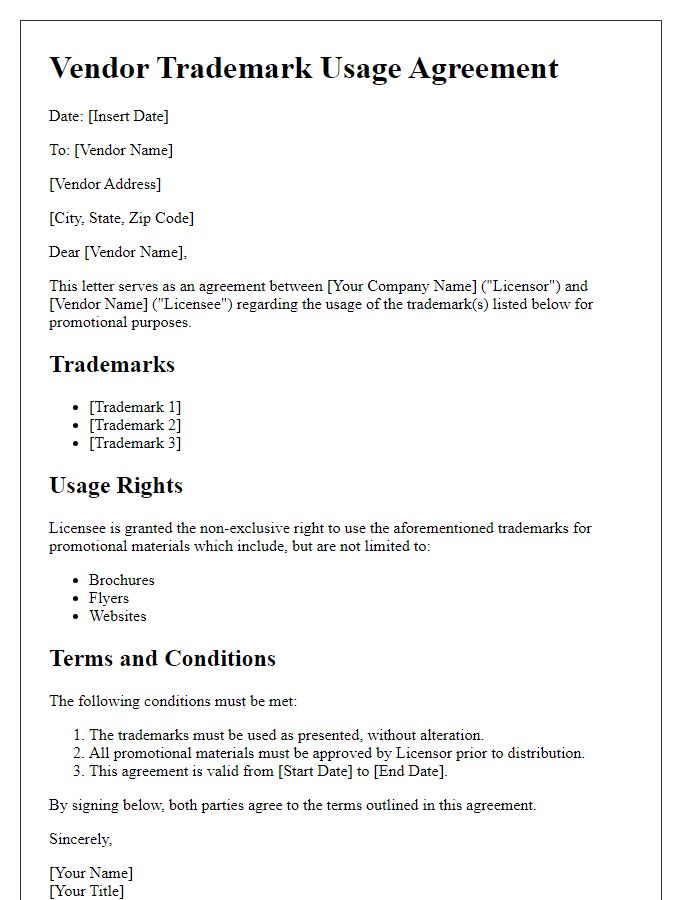Are you a vendor looking to use a brand's trademark in your marketing or products? Understanding the nuances of a trademark usage agreement is crucial to protecting both your interests and those of the brand owner. In this article, we'll break down the key elements of a vendor trademark usage agreement, ensuring you know what to include and why it matters. So, let's dive deeper into this essential topic and explore how to craft an agreement that works for everyone involved!

Vendor Details and Contact Information
A vendor trademark usage agreement encompasses key details regarding the licensing of a trademark owned by one party (the licensor) to another party (the licensee). Important components of this agreement include the vendor details such as full business name (for legal identification), address (to establish jurisdiction), telephone number (for direct communication), email address (for correspondence), and website (for additional business information). The agreement should also specify the intended purpose of the trademark usage, include terms and conditions governing the usage, outline any restrictions, and ensure that both parties are aware of their rights and obligations concerning the trademark. Additionally, the effective date of the agreement and duration of trademark usage should be clearly defined, providing a comprehensive framework for the legal use of the trademark.
Trademark Description and Scope of Use
A vendor trademark usage agreement outlines the terms and conditions under which a vendor may use a trademark owned by another party. This agreement typically includes a detailed description of the trademark, which may consist of specific symbols, logos, or words identified as the brand's intellectual property. For example, a well-known brand like Nike may have its iconic "Swoosh" logo defined here. The scope of use specifies the contexts in which the trademark can be applied, such as promotional materials, product packaging, or branded merchandise. Any limitations on geographical regions (like North America or Europe), product categories (like athletic apparel or footwear), and duration of use (typically specified in years) can also be detailed here to ensure proper and authorized usage of the trademark. Compliance with legal stipulations around trademark usage is crucial to protect both the vendor and the trademark owner's rights.
Usage Guidelines and Restrictions
Trademark usage agreements serve as crucial documents for vendors to ensure proper representation of brand identity. This agreement typically outlines specific guidelines regarding the usage of registered trademarks, such as logos, brand names, and slogans. For instance, vendors must adhere to color schemes, font styles, and sizing requirements to maintain brand integrity. Restrictions may include prohibiting alterations or modifications without prior consent. Locations where the trademark can be displayed, such as marketing materials, product packaging, or digital platforms, are explicitly defined. Compliance with local laws and regulations, particularly regarding trademark infringement, underscores the importance of this agreement. Violations could result in legal actions, including cease-and-desist orders or financial penalties. Successful adherence strengthens brand reputation and fosters long-term relationships.
Compensation and Usage Fees
Vendor trademark usage agreements often include specific terms regarding compensation and usage fees related to the intellectual property rights of the trademark holder. These agreements may outline the percentage of sales or fixed fees that the vendor must pay for the right to use the trademarked name, logo, or other branding elements. The compensation structure could be tiered, where fees increase based on sales thresholds, offering an incentive for the vendor to boost sales while ensuring fair remuneration for the trademark owner. Additionally, clauses may specify payment schedules, such as monthly or quarterly, including details about audits or reporting requirements to verify sales figures. Furthermore, the agreement might stipulate conditions for renewal, termination, or modification of fees, ensuring both parties maintain transparency and mutual understanding concerning the trademark's usage.
Termination and Breach Conditions
In a vendor trademark usage agreement, termination and breach conditions outline specific scenarios that can lead to the end of the contractual relationship between the vendor and the brand owner. Termination rights may arise due to failure to adhere to quality standards established by the brand, or failure to pay licensing fees by the vendor within a predetermined period, often specified as 30 days. Breach conditions can include unauthorized use of trademarked materials, misrepresentation of brand affiliation, or any actions that could potentially damage the brand's reputation. In such cases, the brand owner typically reserves the right to terminate the agreement immediately and may seek damages for any harm caused. Clear documentation of all conditions is essential to protect both parties and ensure compliance with trademark law, governing the correct and authorized use of the brand's intellectual property.
Letter Template For Vendor Trademark Usage Agreement Samples
Letter template of Vendor Trademark Usage Agreement for Promotional Purposes

Letter template of Vendor Trademark Usage Agreement for Co-Branding Initiatives

Letter template of Vendor Trademark Usage Agreement for Marketing Collaboration

Letter template of Vendor Trademark Usage Agreement for Sponsorship Activation

Letter template of Vendor Trademark Usage Agreement for Social Media Campaigns












Comments